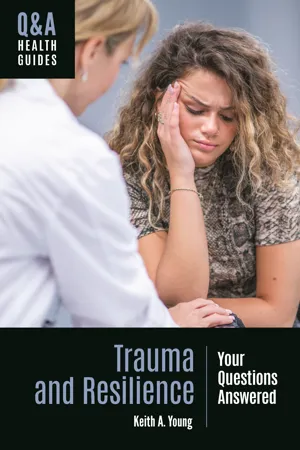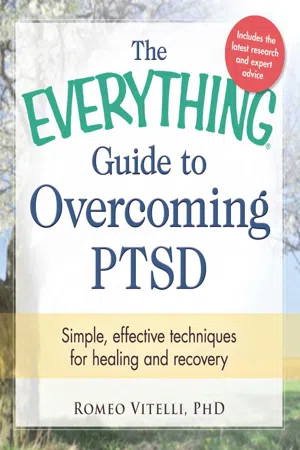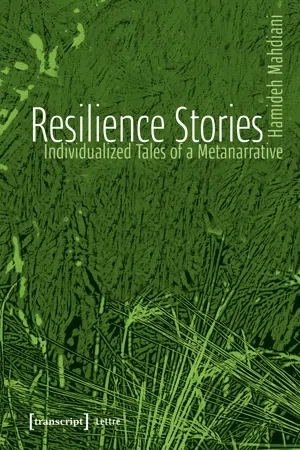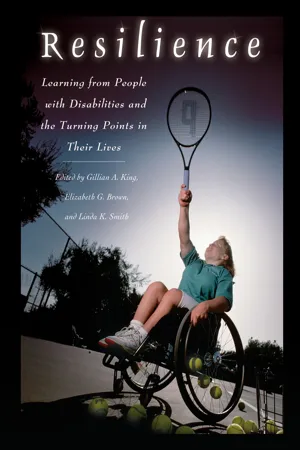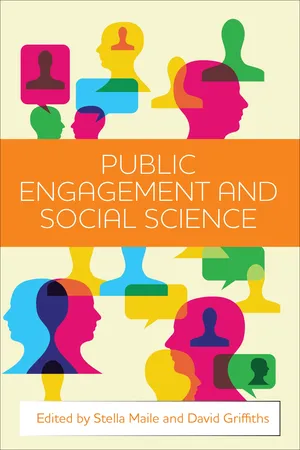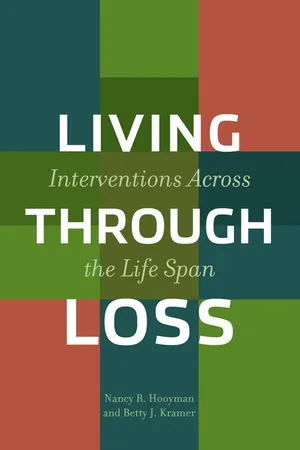Psychology
Resilience
Resilience refers to an individual's ability to adapt and bounce back from adversity, trauma, or stress. It involves the capacity to maintain a sense of well-being and effectively cope with challenges. Resilience is influenced by various factors, including personal traits, social support, and coping strategies, and can be developed and strengthened over time.
Written by Perlego with AI-assistance
Related key terms
1 of 5
11 Key excerpts on "Resilience"
- eBook - ePub
Trauma and Resilience
Your Questions Answered
- Keith A. Young(Author)
- 2021(Publication Date)
- Greenwood(Publisher)
Resilience 21. What is Resilience?Resilience is the durability of our psychological constitution in stressful situations and our ability to adapt to adversity without becoming overwhelmed by it. It’s the protective physiological fortitude that determines how effectively we cope in a moment of crisis and how swiftly we will recover after the crisis has passed. Resilience isn’t one particular asset. It’s a sum total of multiple strengths and attributes that include, among other things, our sense of personal efficacy, the faith we have in ourselves, the degree to which we feel valued and loved by others, our versatility in problem solving, and how effectively we maintain a sense of safety in the world as we understand it. It’s also a measure of wellness and attunement between the mind and the body, including our awareness of somatic distress and how well we’ve learned to tend to it.Resilience is an internal safeguard and our first line of defense against the effects of trauma. It enhances our chances of coming out okay once the danger has passed and we’re on the other side of it. Psychological trauma burdens the mind beyond its threshold to process and metabolize what’s happening. Resilience is what determines how high or low that threshold is set and how much it can be pushed before an overwhelm takes place. It’s a dynamic measure, in that people with high Resilience may become less resilient over time (e.g., from exposure to trauma or compromised wellness), and people with low Resilience can learn skills to raise it. For that reason, you can think of Resilience as both a skill set and the protective bubble that it creates. Resilience gained will speed the process of recovery, and the process of recovery will build Resilience.A high degree of Resilience doesn’t mean that we will never become frazzled or stressed. It doesn’t automatically grant us immunity from becoming traumatized by any particular adverse event. But it does certainly stack the deck in our favor by both mitigating the damage caused and lessening the time it takes to regain our sense of safety. To be resilient doesn’t mean that we become dismissive of horrible things that have happened to us. It isn’t found by closing ourselves off to our emotions or by isolating from connection with others. It’s gained when we’re brave enough to show vulnerability, both to others, when we need to ask for help, and to ourselves, when we’re taking accountability for our choices. Resilience is not false hope. It’s not achieved by staying in unhealthy situations but is what helps us survive and escape them. It’s found in the parts of ourselves that we hold onto for as long as we’re stuck in abusive relationships or traumatic situations and that propel us toward change when it becomes possible. - No longer available |Learn more
- (Author)
- 2014(Publication Date)
- The English Press(Publisher)
________________________ WORLD TECHNOLOGIES ________________________ Chapter-5 Psychological Resilience Resilience in psychology is the positive capacity of people to cope with stress and adversity. This coping may result in the individual “bouncing back” to a previous state of normal functioning, or using the experience of exposure to adversity to produce a “steeling effect” and function better than expected (much like an inoculation gives one the capacity to cope well with future exposure to disease). Resilience is most commonly understood as a process, and not a trait of an individual. More recently, there has also been evidence that Resilience can indicate a capacity to resist a sharp decline in functioning even though a person temporarily appears to get worse. A child, for example, may do poorly during critical life transitions (like entering junior high) but experience problems that are less severe than would be expected given the many risks the child faces. There is also controversy about the indicators of good psychological and social development when Resilience is studied across different cultures and contexts. The American Psychological Association’s Task Force on Resilience and Strength in Black Children and Adolescents, for example, notes that there may be special skills that these young people and families have that help them cope, including the ability to resist racial prejudice. People who cope may also show “hidden Resilience” when they don’t conform with society’s expectations for how someone is supposed to behave (in some contexts, aggression may be required to cope, or less emotional engagement may be protective in situations of abuse). In all these instances, Resilience is best understood as a process. It is often mistakenly assumed to be a trait of the individual, an idea more typically referred to as “resiliency”. - No longer available |Learn more
- (Author)
- 2014(Publication Date)
- The English Press(Publisher)
In all these instances, Resilience is best understood as a process. It is often mistakenly assumed to be a trait of the individual, an idea more typically referred to as “resiliency”. Most research now shows that Resilience is the result of individuals interacting with their environments and the processes that either promote well-being or protect them against the overwhelming influence of risk factors. These processes can be individual coping strategies, or may be helped along by good families, schools, communities, and social policies that make Resilience more likely to occur. In this sense Resilience occurs when there are cumulative protective factors. These factors are likely to play a more and more important role the great the individual’s exposure to cumulative risk factors. The phrase risk and Resilience' in this area of study is quite common. Commonly used terms, which are closely related within psychology, are psychological Resilience, emotional Resilience, hardiness, resourcefulness, and mental tou-ghness. The earlier focus on individual capacity which Anthony described as the “invulnerable child” has evolved into a more multilevel ecological perspective that builds on theory developed by Uri Bronfenbrenner (1979), and more recently discussed in the work of Michael Ungar (2004, 2008), Ann Masten (2001), and Michael Rutter (1987, 2008). The focus in research has shifted from protective factors toward protective processes; trying to understand how different factors are involved in both promoting well-being and protecting against risk. Definition of Resilience Resilience is defined as a dynamic process that individuals exhibit positive behavioral adaptation when they encounter significant adversity, trauma, tragedy, threats, or even significant sources of stress. It is different from strengths or developmental assets which are a characteristic of an entire population, regardless of the level of adversity they face. - eBook - ePub
The Everything Guide to Overcoming PTSD
Simple, effective techniques for healing and recovery
- Romeo Vitelli(Author)
- 2014(Publication Date)
- Everything(Publisher)
CHAPTER 16 What Is Resilience?Not every disaster or traumatic event is going to affect people in the same way. Often defined as “the psychological processes that permit individuals to maintain or return to previous levels of well-being and functioning in response to adversity,” psychological Resilience (or simply Resilience, for short) has become a major focus for research into trauma and child development over the past four decades.Research on Resilience
Beginning in the 1970s, research looking at how well children adjusted to growing up in abusive households found that many of these children seemed relatively unharmed by what was happening around them. Though studies showed that as many as 60–70 percent of abused and neglected children developed behavioral and psychiatric problems later in life, a large minority of these children showed remarkable emotional maturity that protected them and allowed for a fairly normal development despite their upbringing. One researcher, Emmy Werner, coined the term “Resilience” to describe what she was finding with these children.Along with at-risk children, researchers have also looked at Resilience in soldiers, people surviving catastrophic life events, physical and sexual abuse, urban poverty, and refugees. Along with reduced risk of PTSD, high Resilience has been linked to lower risk of suicide, reduced risk of substance abuse, depression, and other psychiatric symptoms. Resilient people are also less likely to have health complaints and function better in stressful situations.There can be different ways of measuring Resilience, including whether people cope well with stress, have good outcomes despite being exposed to high levels of stress, recover well from trauma, and are able to learn from their previous traumatic experiences to protect themselves in future. Though Resilience is often linked to cultural differences in survivors, it also appears to involve different types of protective factors that can limit the impact of traumatic events on survivors. These can include: - eBook - PDF
- Brian J Lukey, Victoria Tepe(Authors)
- 2008(Publication Date)
- Routledge(Publisher)
134 References ............................................................................................................ 135 Psychophysiology of Resilience to Stress Several years ago, researchers began to consider why some people were better able to endure and overcome the stress associated with potentially traumatic events than others. The ability to confront and adapt to stress and adversity is now commonly referred to as Resilience (Block & Kremen, 1996). Although 118 Biobehavioral Resilience to Stress the construct of Resilience is not yet well-defined in terms of its essential contributing factors, it is clear that Resilience promotes effective adjustment to adversity. As such, it may help us to better understand key characteristics and coping strategies that enable some individuals to avoid the potentially debilitating effects of extreme stress and trauma. For example, in a study that examined postbereavement responses, resilient people were those who were characterized as experiencing less enduring grief symptoms after the loss of a loved one (Bonanno et al., 2002). After controlling other predictors such as subjective well-being, researchers found that resilient individuals also scored higher on indexes of global adjustment, work and social adjustment, and psychological and physical health adjustment (Klohnen, 1996). Fredrickson, Tugade, Waugh, and Larkin (2003) found that after the September 11, 2001, terrorist attack on the World Trade Center, self-reported resilient people felt more positive emotions in response to the event (but nearly the same nega-tive emotions), and these positive emotions were associated with a reduced incidence of depression (Fredrickson et al., 2003). Certainly, Resilience also plays a role in confronting the daily stresses of ordinary life. - eBook - PDF
Resilience Stories
Individualized Tales of a Metanarrative
- Hamideh Mahdiani(Author)
- 2021(Publication Date)
- transcript Verlag(Publisher)
Increasingly, researchers focused on identifying the characteristics of individuals, particularly young people, who thrived while living in difficult circumstances, such as poverty and parental mental illness. 4 Examples of such qualities were: an easy temperament, good self-esteem, planning skills, and 2 See for example, Garmezy, Vulnerability ; Garmezy, Competence ; Masten and Powell, Resilience Framework. 3 See, Garmezy, Stress ; Garmezy et al., Study of Stress ; Garmezy and Rutter, Stress. 4 See Garmezy, Resilience in Children ; Rutter, Commentary ; Werner & Smith, Overcoming . Life Sciences and Narratives of Resilience 37 a supportive environment inside and outside the family. Thus, the thrust of early research examining Resilience was the search for factors that protect an individual from the stressors they encounter and distinguishing between those who adapt to the circumstances and those who succumb to negative environmental factors. Prince-Embury writes that several existing definitions of Resilience share a number of features all relating to human strengths, some type of disruption and growth, adaptive coping, and positive outcomes following exposure to adversity. There are also a number of distinctions made in attempts to define this construct. For example, some investigators assume that Resilience is located “within a person” (Prince-Embury, Translating Resilience 9). Others propose that there are multiple sources and pathways to resiliency, including social context (e.g., family, external support system). Luthar et al. ( The Construct 545) separate the definitions of Resilience as a developmental process from that of resiliency 5 which is a characteristic of an individual’s personality. Suniya S. Luthar and Dante Cicchetti define Resilience as “a dynamic process wherein individuals display positive adaptation despite experiences of significant adversity or trauma” (858). - eBook - PDF
Resilience
Learning from People with Disabilities and the Turning Points in Their Lives
- Gillian King, Elizabeth G. Brown, Linda K. Smith, Gillian King, Elizabeth G. Brown, Linda K. Smith(Authors)
- 2003(Publication Date)
- Praeger(Publisher)
Chapter 3 THE RESILIENT SELF—WHAT HELPS AND WHAT HINDERS? Colleen Willoughby, Elizabeth G. Brown, Gillian A. King, Jacqueline Specht, and Linda K. Smith Reading through the previous chapter on turning points makes it evident that each person in our study experienced personal triumphs and struggles throughout their life's journey. One common theme that resonates through each person's life story is the ability to cope with life's setbacks and keep going. This reflects the notion of the resilient self. The academic literature on Resilience deals with the factors and pro- cesses that keep us going when faced with the challenges of life. This lit- erature indicates that people with chronic conditions or disabilities are at greater risk for behavioral and emotional problems such as aggression, conflicts with peers, hyperactivity, depression, anxiety, and isolation from others (Brooks, 1994; Lavigne & Faier-Routman, 1992). Yet only a small proportion of adults with disabilities experience these serious problems. Why is this? We want to know why so we can understand how to work toward ensuring that all of us—those with and those without disabilities— can be protected from the risks we will undoubtedly encounter during our life courses. Webster's Dictionary defines Resilience as "an ability to recover from or adjust easily to change or misfortune." Some of the people in our study may question this definition. They may feel that the adjustment was not always "easy." Nonetheless, they bounced back from many negative events and continued on with their lives. When we say that each person demonstrated an ability to cope, this is not meant to imply that somehow the participants were a select sample of extraordinarily resilient individ- 90 Resilience uals or that they did not experience struggles or difficulties. - eBook - PDF
- Maile, Stella, Griffiths, David(Authors)
- 2014(Publication Date)
- Policy Press(Publisher)
So what is personal Resilience? Well one thing is clear, it is not some kind of universal quality that someone has that will see them through any kind of adverse situation.The setting or context is crucial. Someone who might be tremendously resilient when working long hours in a stressful working environment like the city may quickly crumple when faced with the prospect of living with a chronic and enduring illness. Or a quality such as the capacity to be in touch with your feelings, which may contribute enormously to the Resilience of a middle-class child faced with multiple bereavements, may contribute negatively 163 Resilience to the Resilience of a child in a tough inner city environment where children have to quickly learn to keep their feelings to themselves. So, just because someone shows Resilience in one situation does not mean that they will show it in another. But if Resilience is situation-specific, this means that it may also vary across time. In other words, a resilient child may not become a resilient teenager, and a resilient teenager may not become a resilient adult.We do not carry Resilience with us as if it were some kind of resource in a rucksack that we can pull out when required. So, it probably follows that none of us can ever quite be sure how we will respond to different kinds of adversity – bereavements, the loss of life chances that comes with redundancy or educational failure, poverty, civil strife, forced migration, illness, and so on. Indeed, it is even more uncertain than this, we might cope with the death of a loved father quite easily but the death of a mother may throw us into a prolonged period of mental turmoil.This is the problem with a lot of the psychological research on Resilience: it deals with big numbers and general patterns and therefore tends to assume that a loss is a loss is a loss. But it is not; the loss of a job will mean one thing to one person but something quite different to another. - Available until 27 Jan |Learn more
Living Through Loss
Interventions Across the Life Span
- Nancy R. Hooyman, Betty J. Kramer(Authors)
- 2006(Publication Date)
- Columbia University Press(Publisher)
We believe that each of us who has suffered loss and found ways to integrate that loss into our lives is, to some extent, resilient. We are active, not passive, that is, acted upon by outside events as we build up a sense of our own Resilience and vulnerability over a lifetime. Human beings’ capacity for growth and development can last for a lifetime if they embrace, understand, and learn from their experiences. The concept of Resilience, rather than deficit, affects interventions with and the types of supports provided to those who are grieving a loss. The Resilience framework presented here is not a developed theoretical model but an alterna-tive way of conceptualizing the grieving process that takes account of cultural, community, and social resources and capacities. At this early stage of its formu-lation, it is a way of organizing one’s thinking about grief that offers a wider context than the more individually oriented psychodynamic and stress and coping models. The early research in the area of Resilience identified those factors associated with successful adaptation by children and youth living in high-risk situations due to environmental factors such as poverty and violence. Although most resil-ience research continues to focus on identifying risk factors and how protective 66 Resilience and Meaning Making factors moderate psychosocial outcomes in children (Benson 1997 ; Hawkins et al. 1999 ; Herrenkohl et al. 2000 ), Resilience as a conceptual framework can also be relevant to understanding how individual, family, community, and cultural capacities can protect people from the disruptions of loss. In presenting this framework as one way to organize and conceptualize the wide range of factors that affect the outcomes of loss, we rely primarily on the work of McCubbin and McCubbin ( 1993 ) and Fredriksen-Goldsen ( 2006 ). - eBook - PDF
- Spencer A. Rathus, Jeffrey S. Nevid(Authors)
- 2021(Publication Date)
- Wiley(Publisher)
123 CHAPTER 5 Resilience and Coping M_a_y_a/E+/Getty Images LEARNING OUTCOMES After studying this chapter, you will be able to . . . 1. Identify factors that foster Resilience to stress. 2. Explain problematic ways of coping with stress. 3. Explain the role of cognitive appraisal in coping with stress. 4. Describe problem-focused methods of coping with stress. 5. Describe emotion-focused methods of coping with stress. 124 CHAPTER 5 Resilience and Coping People and groups differ in their sensitivity and vulnerability to certain types of events, as well as in their interpretations and reactions. Under comparable conditions, for example, one person responds with anger, another with depression, yet another with anxiety or guilt; and still others feel challenged rather than threatened. Likewise, one individual uses denial to cope with terminal illness whereas another anxiously rumi- nates about the problem or is depressed. One individual handles an insult by ignoring it and another grows angry and plans revenge. —Lazarus & Folkman, 1984, pp. 22–23. Resilence As noted by Lazarus and Folkman (1984), some people are more resilient in the face of stress than others. Though we all have our limits, there is no one-to-one relationship between the amount of stress we experience and outcomes such as physical disorders or psychological dis- tress. Biological factors account for some of the variability in our responses. For example, some people may inherit predispositions that increase their risk of developing certain physical and psychological disorders following stressful experiences. But psychological factors also influ- ence our Resilience to stress. Psychological Hardiness: Tough Enough? Health psychologists focus on psychological factors associated with Resilience to stress. One such factor that helps people resist stress is a personality trait called psychological hardiness. - eBook - PDF
- (Author)
- 2022(Publication Date)
- For Dummies(Publisher)
Those most associated with Resilience are believing that success is possible (optimism), viewing diffi -culties as opportunities for growth and learning, having the willingness to push forward, being able to accept change, and being open to making mistakes and learning from failures. All these traits can be cultivated with practice and also aren’t purely dependent on upbringing and genetics. Embarking on the Journey to Resilience CHAPTER 1 Embarking on the Journey to Resilience 179 Coping habits Coping habits are habits you have developed that have helped you get through challenges or difficulties. In general, there are two types of coping habits: » Adaptive habits are the behaviors that help you cope with stress that are also healthy for the mind and body. » Maladaptive habits are behaviors that might reduce anxiety and therefore help you cope but are themselves destructive to your health. Confronting your fears head-on, appraising situations realistically, calming your emotions, and maintaining healthy behaviors — such as good sleep hygiene and a balanced exercise-and-nutrition regimen — are examples of adaptive coping habits. Choosing to avoid dealing with fear and drinking alcohol, binge eating, or throwing yourself into work so that you aren’t sleeping, exercising, or eating appropriately are examples of maladaptive coping habits. Some adaptive coping habits that improve Resilience are exercising (see Book 4), eating a healthy diet (see Book 5), meditating (see Book 1), accessing social sup-port, connecting to spirituality, learning to reappraise thoughts and beliefs, regu-lating emotions, and partaking in altruistic activities. These habits can be learned and cultivated, even when maladaptive coping has been the norm. Social support Support comes in the form of family, intimate partners, colleagues, neighbors, friends, spiritual community members, and others.
Index pages curate the most relevant extracts from our library of academic textbooks. They’ve been created using an in-house natural language model (NLM), each adding context and meaning to key research topics.
